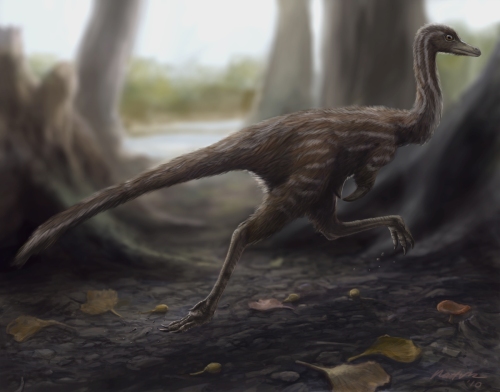Around the time Haplocheirus hit the journals I commented that this would likely be a good year for Chinese alvarezsaurs. Obviously I rather had some insider knowledge and here’s part of that reason – Xixianykus zhangi. This is a new and really rather small alvarezsaur from Xixa county in Henan, China – a place far more famous for its fossil eggs and isolated baryonychine tooth.
Aside from being the latest taxon in a rather small clade, and having a fair amount of the skeleton intact, Xixinykus has some more interesting things going for it. For a start it does seem to be especially cursorial (that is, adapted for running) which can be seen by a number of anatomical specialisations especially (unsurprisingly) in the legs but also in the body. Despite likely only being likely around half a metre long, the legs on this thing are about 20 cm long. Being fast requires both a long stride length and / or as high stride frequency and Xixianykus as the former in spades at least. This is also combined with proportionally increasing distal parts of the limb (a short femur and a long tibia / metatarsus) which is another good indicator of cursoriality and is higher for Xixianykus than almost all other theropods. Whether or not is did run much is another question entirely, but when it did, it was probably quick. It was also efficient – there are structural adaptations in the body that would have reduced swaying, cutting down energy loss and the short femur also draws muscle mass up the legs making them more efficient (you don’t have to move all that heavy leg muscualture so far than if it was, to take an extreme example, on the foot say).
This is also a fairly old taxon, among the derived alvarezsaurs (the parvicrusorines) this is phylogenetically one of the most basal and the oldest. It’s dated to Santonian-Conacian as opposed to the others which are either Campanian or Maastrichtian. Based on the available material this suggests the possibility of an Asian origin for the group that later dispersed to North America.
Finally, I should add a quick, but large, ‘thank you’ to Matt Van Rooijen author of the Optimistic Painting blog for his reconstruction of the animal. Please don’t rip it off, it’s his artwork, on loan (if you like) to the Musings. If you want to use it, ask him, even if you do see it on various media sites.
A basal parvicursorine (Theropoda: Alvarezsauridae) from the Upper Cretaceous of China
XING XU, DE-YOU WANG, CORWIN SULLIVAN, DAVID W. E. HONE, FENG-LU HAN, RONG-HAO YAN & FU-MING DU (P.R. China). Zootaxa, 2413 1-19.


I commend you on using Parvicursorinae instead of Mononykinae. 🙂
Thank Jonah Choiniere for catching that one in the review phase.
Holy cow, that’s an awesome restoration. I really look forward to reading about this new guy. It certainly is a good year for alvarezsaurs, and I’ll mention Xixiankyus on the podcast next month. Hopefully, I won’t butcher the name.
(Zi-ZANG-kus?)
X is a ‘sh’ in Chinese. So it’s She-she-ah-nye-kuss.
The in the syllable xia isn’t a real vowel, more like a “y” sound, so it’s just “shee-shah”
Argh. Last comment should read:
The i in the syllable xia isn’t a real vowel, more like a “y” sound, so it’s just “shee-shah”
Another new alvarezsauroid! YES!!!
Very cool—I think I saw the specimen kicking around your office, no? Strange and annoying, though, that neither Bristol nor Monash provide access to _Zootaxa_…
You may have done Roger. Errrm, there’s actually several alvarezsaur bits of varying interest and newness kicking around the IVPP at the moment. 😉 I don’t know which one you saw?
David;
Your cheating, being based out of China 😉
Give everyone my best and since I’m not coming to China this year, everyone should come over and help out with excavating all our Utah dinosaurs.
Silly as it might sound Jim, it’s actually starting to get annoying. I spend too much of my time on descriptions and taxonomy / systematics, when i want to be getting on with my own research themes. I did manage to slip some ecology into the Xixinykus paper, but you should see the list of things I have to describe. It’s getting out of hand. Really.
But, but, the o in onych- ‘nail, claw’ is part of the root, not a connecting vowel, so the name should really be…oh, never mind.
Well we don’t pretend to be Latin or Greek scholars, and when combining Chinese with another ancient language, things tend to be a bit fudged, rather by definition. That phonetic explanation I tried to give is based on what Xu Xing wanted it called as best I could manage.